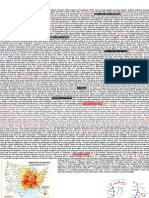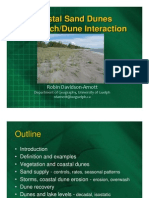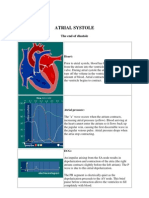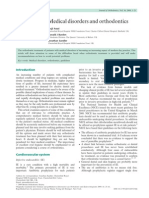Circulatory System
Circulatory System
Uploaded by
chelliCopyright:
Available Formats
Circulatory System
Circulatory System
Uploaded by
chelliOriginal Title
Copyright
Available Formats
Share this document
Did you find this document useful?
Is this content inappropriate?
Copyright:
Available Formats
Circulatory System
Circulatory System
Uploaded by
chelliCopyright:
Available Formats
MECHANICAL VALVES
mechanical prosthesis : bileaflet valves
AORTIC Valve Stenosis
- experience the full force of heart’s pumping
action
- exposed to higher blood pressure
- stronger and more elastic
ELASTIN – allows arteries to stretch and recoil
BLOOD VESSELS
SMOOTH MUSCLE – allows them to dilate and constrict
Blood vessels form a tubular network throughout the
body that allows blood to flow from the heart to every
body cell and then back to the heart.
ARTERY
-carries blood away from the heart
-carries oxygenated blood (except pulmonary arteries
VEIN - blood pressure is low
carries blood to the heart - have thinner walls and lumen is larger
-carries DEoxygenated blood (except pulmonary veins) - have valves
CAPILLARIES Factors Aiding Venous Return
exchange of materials between the blood and tissue 1. Muscular pump: contraction of skeletal muscles
cells "milks" blood toward heart; valves prevent backflow
-smallest and most numerous of the blood vessels 2. Respiratory pump: pressure changes during
breathing move blood toward heart by squeezing
abdominal veins as thoracic veins expand
3. Venoconstriction under sympathetic control pushes
blood toward heart
CAPILLARIES period of relaxation (diastole)
• Link between arteries and veins - the heart ventricles fill with blood.
• Sites where molecules are exchanged between One complete sequence of filling and pumping blood is
blood and interstitial fluid called a cardiac cycle, or heartbeat.
ELECTRICAL ACTIVITY OF THE HEART
Sinoatrial Node (SA node)/ pacemaker
- controls heart's rhythm of contraction
• The heart will beat without input from the
nervous system
• continue to beat, even outside the body, as
long as its cells are alive
• Automaticity is due to the spontaneous
Pulmonary Circuit- blood takes up oxygen in the lungs
electrical activity of the SA node. Electrical
1. Right Ventricle impulses generated from the SA node spread
2. Pulmonary Valve through the heart via a nodal tissue pathway
3. Pulmonary Trunk that coordinates the events of the cardiac
4. Pulmonary Arteries cycle.
5. Pulmonary Arterioles
Components of Blood
6. Capillaries
7. Pulmonary Venules PLASMA
8. Pulmonary Veins
9. Left Atrium - a mixture of: proteins enzymes nutrients
10. Bicuspid Valve wastes hormones gases
- transport substances around the body
Systemic Circuit- oxygenated blood is distributed to
body tissues.
11. Left Ventricle
12. Aortic Valve
13. Aorta
14. Systemic Arteries
15. Systemic Arterioles
16. Capillaries
17. Systemic Venules
18. Systemic Veins
19. IVC/SVC
20. Right Atrium
21. Tricuspid Valve
The Cardiac Cycle
- alternate contraction and relaxation
of the chambers of the heart
- a rhythmic cycle
period of contraction (systole)
- the ventricles pump blood out through the arteries;
BLOOD PRESSURE
White Blood Cells (WBC)or leukocytes - generated by heart contractions
- fluid pressure that blood exerts against vessel
- integral part of the human immune system
- walls expressed in mm Hg
- fight infections by attacking bacteria, viruses,
and other foreign pathogens that invade the
body
- too many or too few white blood cells can
indicate a blood disorder
- disorders affecting these cells often result in
the body’s inability to eliminate or control
infections.
Measuring blood pressure
- Sphygmomanometer
DISEASES OF THE CIRCULATORY SYSTEM
ATHEROSCLEROSIS
• Associated with cholesterol build up called
plaque inside walls of the arteries
• arteries harden and lose their elasticity
Prevention
- Avoid too much fat in the diet!
- Quit smoking!
- Control one’s weight
- Exercise!
STROKE (CEREBROVASCULAR ACCIDENT)
• results from the blockage brought by the
hardening of arteries in the brain or neck
vessels
EMBOLUS – wandering clot
THROMBUS – blood clot fixed within a blood vessel • Causes damage to the heart such as:
HEMORRHAGE – bursting of a diseased artery - damage to one or more heart valves that
remains after an episode of acute rheumatic fever (ARF)
CORONARY HEART DISEASE
- ENDOCARDITIS – inflammation of the
• Inability of the blood to reach the coronary
innermost layer of the heart
arteries of the heart
Caused by:
- aging
- atherosclerosis
Reduced blood flow leads to:
ANGINA PECTORIS- Painful sensation in the chest, left
arm and shoulder
symptoms of moderate to severe RHD can include:
• chest pain
• breathlessness with physical activity or when
lying down
• weakness and tiredness
• and swelling of the legs and face
DISORDERS OF THE BLOOD
HYPERTENSIVE HEART DISEASE
ANEMIA
• Elevated blood pressure
• RBC count stays permanently low (below 4M)
• Results from tightening of arterioles • Caused by nutritional deficiencies, diseases or
injuries associated with organs for blood cell
formation
• Iron-deficiency anemia can be treated with
iron-supplements and iron-rich foods
LEUKEMIA
• Abnormal increase in white blood cells
• One of the most dangerous blood disorders
• (acute leukemia) the marrow produces
monster-sized, cancer-looking WBCs
RHEUMATIC HEART DISEASE
• Usually occurs in children
• Strats from untreated bacterial infection
caused by Streptococcus pyogenes
• Patient suffers from rheumatic fever
CIRCULATORY SYSTEM
Heart Anatomy & Basic Function
• Cardiovascular = Heart, Arteries, Veins, Blood
• Function:
– Transportation
– Blood = transport vehicle
– Carries oxygen, nutrients, wastes, and
hormones
• Human heart has 4 chambers
– Movement provided by pumping of
– 2 Atria
heart
• Superior = primary receiving
CARDIAC TISSUES
chambers, do not actually pump
• Blood flows into atria
– 2 Ventricles
• Pump blood
• Contraction = blood sent out of
heart > circulated
• Chambers are separated by septum…
– Outermost = Pericardium & Epicardium – Due to separate chambers, heart
functions as double pump
– Pericardium is a membrane anchoring
heart to diaphragm and sternum CARDIAC VALVES
– Pericardium secretes lubricant (serous
fluid)
– Epicardium is outermost muscle tissue
– Middle = Myocardium
– Contains contractile muscle fibers
– Innermost = Endocardium MITRAL Valve Stenosis
– Lines Cardiac Chambers
CARDIAC CHAMBERS
You might also like
- Test Bank For Essentials of Pathophysiology 3rd Edition, PorthDocument23 pagesTest Bank For Essentials of Pathophysiology 3rd Edition, PorthILL11050% (2)
- Continents and Oceans of The World PowerPointDocument20 pagesContinents and Oceans of The World PowerPointIoannis Klonizakis100% (1)
- Week 4 - Module 1 - (1) Location & Definition of The CaribbeanDocument5 pagesWeek 4 - Module 1 - (1) Location & Definition of The CaribbeanMathias MooreNo ratings yet
- 37 1Document3 pages37 1MoneymakerNo ratings yet
- Earth's Fresh Water - Dynamic PlanetDocument7 pagesEarth's Fresh Water - Dynamic Planetar_gon214No ratings yet
- Heart Lung Abdomen ExamDocument1 pageHeart Lung Abdomen ExamJOUO20009167No ratings yet
- Manibabhula Nursing College, Bardoli: Subject: Medical Surgical Nursing Topic: Case Study OnDocument18 pagesManibabhula Nursing College, Bardoli: Subject: Medical Surgical Nursing Topic: Case Study Onmeghana100% (7)
- Handout 10 Circulatory SystemDocument2 pagesHandout 10 Circulatory SystemKyle QuietaNo ratings yet
- Lesson Plan Gr. 4 Mathematics LengthDocument18 pagesLesson Plan Gr. 4 Mathematics LengthbabongilevaniNo ratings yet
- Unit 3 - Measurement - Part 1: Assignment Title Notes To Self CompleteDocument21 pagesUnit 3 - Measurement - Part 1: Assignment Title Notes To Self Completeapi-507790029No ratings yet
- OceansDocument3 pagesOceansAprilNo ratings yet
- Continents and Oceans Blank MapDocument2 pagesContinents and Oceans Blank Map王小溪No ratings yet
- Renewable EnergyDocument12 pagesRenewable EnergyfareshmahranNo ratings yet
- Grade 6 Social Studies Weeks 1-4 Worksheets - Term 2Document48 pagesGrade 6 Social Studies Weeks 1-4 Worksheets - Term 2hummeraillahiNo ratings yet
- Comparative and Superlative AdjectivesDocument5 pagesComparative and Superlative Adjectiveseman abdelhaqNo ratings yet
- PollinationDocument5 pagesPollinationMenakadevi MarkandanNo ratings yet
- Landforms and Bodies of Water: Complete Each Sentence With A Word From The Box. Some Words Will Not Be UsedDocument2 pagesLandforms and Bodies of Water: Complete Each Sentence With A Word From The Box. Some Words Will Not Be UsedRob ClosasNo ratings yet
- Name: Teacher: Date: Score:: Identify and Calculate The Perimeter For Each TriangleDocument2 pagesName: Teacher: Date: Score:: Identify and Calculate The Perimeter For Each TrianglepsaayoNo ratings yet
- Types of Triangles GCSE WorksheetDocument14 pagesTypes of Triangles GCSE WorksheetSouvik GhoshNo ratings yet
- 1 Soil ResourcesDocument24 pages1 Soil ResourcesBelle ÂmeNo ratings yet
- Class 5 Sst3Document1 pageClass 5 Sst3Ajay MishraNo ratings yet
- Urbanization: Causes, Problems and SolutionsDocument15 pagesUrbanization: Causes, Problems and SolutionsAriel TaylorNo ratings yet
- TX 5.8B TheSunandWaterCycle EXPLAIN STEMscopediaDocument6 pagesTX 5.8B TheSunandWaterCycle EXPLAIN STEMscopediaCinta KimiaNo ratings yet
- Module 4-Renewable and Non-Renewable Energy 5Document57 pagesModule 4-Renewable and Non-Renewable Energy 5PRAVIN GNo ratings yet
- Weathering and Soil FormationDocument26 pagesWeathering and Soil FormationrudyNo ratings yet
- Conductors and InsulatorsDocument17 pagesConductors and InsulatorsRichard PalaciosNo ratings yet
- Metric and Imperial Linear ConversionsDocument4 pagesMetric and Imperial Linear ConversionsJoselyn MessinaNo ratings yet
- Area of A CircleDocument2 pagesArea of A CircleHandri eko100% (1)
- CH 16 Earth ScienceDocument14 pagesCH 16 Earth ScienceazhafizNo ratings yet
- Diseases and Disorders of The Skeletal SystemDocument11 pagesDiseases and Disorders of The Skeletal SystemJames Roy100% (1)
- Examples:: Dis + Approve Disapprove (Not Approve) Non + Toxic Nontoxic (Not Toxic) Un + Happy Unhappy (Not Happy)Document8 pagesExamples:: Dis + Approve Disapprove (Not Approve) Non + Toxic Nontoxic (Not Toxic) Un + Happy Unhappy (Not Happy)Alisa BilokinNo ratings yet
- CONDUCTORS and INSULATORSDocument22 pagesCONDUCTORS and INSULATORSMARIA SHERYL WANIWANNo ratings yet
- WeatheringDocument13 pagesWeatheringBrijeshNo ratings yet
- CloudsDocument34 pagesCloudsBai haifha DudinNo ratings yet
- Sci Cheat SHeet For MOAT (Text)Document1 pageSci Cheat SHeet For MOAT (Text)whatthefail0% (1)
- VolcanoesDocument10 pagesVolcanoesShazira AllyNo ratings yet
- Caribbean Studies Worksheet: Defining The CaribbeanDocument4 pagesCaribbean Studies Worksheet: Defining The CaribbeanKelsey WilsonNo ratings yet
- Different Landforms: by Jena CarrollDocument20 pagesDifferent Landforms: by Jena CarrollMeredith AlexanderNo ratings yet
- Interactive PowerpointDocument12 pagesInteractive PowerpointRahul DeshmukhNo ratings yet
- Respiratory System PPT (Biology)Document8 pagesRespiratory System PPT (Biology)Maxxdlc 16No ratings yet
- Coastal Dunes RDADocument50 pagesCoastal Dunes RDAMagda NechitaNo ratings yet
- Dispersal of Seeds by FruitsDocument6 pagesDispersal of Seeds by FruitsAnil PantNo ratings yet
- Light and SoundDocument16 pagesLight and SoundMichaelle BunaoNo ratings yet
- Fess 206Document8 pagesFess 206Vinayak ThaparNo ratings yet
- WS (Part-1) L-3 The Northern Mts AnsKeyDocument1 pageWS (Part-1) L-3 The Northern Mts AnsKeyruchi gulatiNo ratings yet
- Landforms PowerpointDocument21 pagesLandforms PowerpointJhaypee SorianoNo ratings yet
- Types of LandformsDocument11 pagesTypes of LandformsLM - 07GD 827163 Camilla Road Sr PSNo ratings yet
- Earth, Sun, Moon Scavenger HuntDocument2 pagesEarth, Sun, Moon Scavenger HuntFatma Yılmaz100% (1)
- Reviewer EarthScie. L1 - L10Document8 pagesReviewer EarthScie. L1 - L10KyleNo ratings yet
- Weather: What Is Wind?Document8 pagesWeather: What Is Wind?ruvinNo ratings yet
- Illustrated Glossary Geo TermsDocument8 pagesIllustrated Glossary Geo TermsfelicianoelaineNo ratings yet
- ESS - 8 Volcanoes and EarthquakesDocument5 pagesESS - 8 Volcanoes and EarthquakesMr. LiraNo ratings yet
- SuffixesDocument2 pagesSuffixesAmila Grahovic100% (2)
- Plant Parts and FunctionsDocument63 pagesPlant Parts and FunctionsmacybnzNo ratings yet
- Science Ecology Review Cheat Sheet: by ViaDocument5 pagesScience Ecology Review Cheat Sheet: by ViaCWRNo ratings yet
- Map Work Techniques: 2015 A LevelsDocument18 pagesMap Work Techniques: 2015 A LevelsAndisiwe Mitchell NtongaNo ratings yet
- Class 5 - Social Studies ChapterDocument4 pagesClass 5 - Social Studies ChapterSharmistha KarNo ratings yet
- Third Space Learning 2D Shapes GCSE WorksheetDocument19 pagesThird Space Learning 2D Shapes GCSE WorksheetNghia Nguyen VanNo ratings yet
- Bones of The Human BodyDocument21 pagesBones of The Human Bodyapi-349755868No ratings yet
- Earth SeasonsDocument18 pagesEarth SeasonsDave Cercado BugadorNo ratings yet
- Q4 - 1ST Summative Test Science 7Document2 pagesQ4 - 1ST Summative Test Science 7Aj De CastroNo ratings yet
- ASB0205 23.24 T7 - StudentsDocument30 pagesASB0205 23.24 T7 - Studentsfatihah abdullahNo ratings yet
- MS Term 1Document7 pagesMS Term 1Abegail QuintoNo ratings yet
- Sistem Jantung - SaladinDocument128 pagesSistem Jantung - SaladinJuli Damayanty Harahap100% (1)
- Cambridge International AS & A Level: Biology 9700/11Document20 pagesCambridge International AS & A Level: Biology 9700/11kshitizshresthaNo ratings yet
- Experiment Procedure Summary - 0Document35 pagesExperiment Procedure Summary - 0Craig Ó BrádaighNo ratings yet
- Basic CathlabDocument26 pagesBasic Cathlabwiwing100% (2)
- CARDIAC CYCLE New For StudentDocument54 pagesCARDIAC CYCLE New For StudentDavi DzikirianNo ratings yet
- Direction: Encircle The Letter of The Correct AnswerDocument2 pagesDirection: Encircle The Letter of The Correct Answerariel agos100% (1)
- Martin Zenker-Noonan Syndrome and Related Disorders - A Matter of Deregulated Ras Signaling (Monographs in Human Genetics Vol 17) - S. Karger AG (Switzerland) (2009)Document178 pagesMartin Zenker-Noonan Syndrome and Related Disorders - A Matter of Deregulated Ras Signaling (Monographs in Human Genetics Vol 17) - S. Karger AG (Switzerland) (2009)Lupu AndreeaNo ratings yet
- Semi-Final Exam in AnatomyDocument3 pagesSemi-Final Exam in AnatomyEdmund Lominoque LamelaNo ratings yet
- Supporting Letter Evidence-CompressedDocument35 pagesSupporting Letter Evidence-CompressedHeena ShahNo ratings yet
- Atrial Systole: The End of DiastoleDocument9 pagesAtrial Systole: The End of DiastoleSophia MahboobNo ratings yet
- Chest Physical Examination: Paltep, Rashell Anne C. Family Medicine PGI September, 2020Document23 pagesChest Physical Examination: Paltep, Rashell Anne C. Family Medicine PGI September, 2020Rash PaltepNo ratings yet
- Evaluation and Management of Right-Sided Heart FailureDocument45 pagesEvaluation and Management of Right-Sided Heart FailureFreddy PanjaitanNo ratings yet
- Circ TESTDocument5 pagesCirc TESTCabo VlogNo ratings yet
- Firoz Mia - 20210910 - 0001Document11 pagesFiroz Mia - 20210910 - 0001Abdullah al ImranNo ratings yet
- Life Sciences P3 GR 10 Exemplar 2012 Memo EngDocument4 pagesLife Sciences P3 GR 10 Exemplar 2012 Memo EngndumisomokhehleNo ratings yet
- Ventricular Septal Defects in AdultsDocument13 pagesVentricular Septal Defects in AdultsМихаил НеболеевNo ratings yet
- 0610 BIOLOGY: MARK SCHEME For The October/November 2011 Question Paper For The Guidance of TeachersDocument10 pages0610 BIOLOGY: MARK SCHEME For The October/November 2011 Question Paper For The Guidance of TeachershiNo ratings yet
- Medical Disorders and OrthodonticsDocument21 pagesMedical Disorders and OrthodonticsAmir Mir67% (3)
- Insuficiencia MitralDocument13 pagesInsuficiencia MitralSilverius Seantoni SabellaNo ratings yet
- IGCSE Biology Notesss YehahahaDocument133 pagesIGCSE Biology Notesss YehahahaDIO yesNo ratings yet
- Through The Decades (Beta) - Blocker Use and Outcomes in Acute Coronary Syndromes.Document8 pagesThrough The Decades (Beta) - Blocker Use and Outcomes in Acute Coronary Syndromes.Tony Miguel Saba SabaNo ratings yet
- Heart Failure and AnaesthesiaDocument7 pagesHeart Failure and AnaesthesiaShinta RizkyNo ratings yet
- 6.2 - Heart Dissection PracticalDocument7 pages6.2 - Heart Dissection PracticalSaadia NomanNo ratings yet
- Lab Activity (Dissection of Pigs Heart)Document3 pagesLab Activity (Dissection of Pigs Heart)Emily Dueñas SingbencoNo ratings yet
- Cardiac Cycle and Myogenic Control of HeartbeatDocument25 pagesCardiac Cycle and Myogenic Control of HeartbeatFiona HennahNo ratings yet
- Developmental Lesson Plan: The HeartDocument4 pagesDevelopmental Lesson Plan: The Heartapi-298312370No ratings yet
- Cardiac UltrasoundDocument72 pagesCardiac Ultrasoundramon100% (6)

























































































